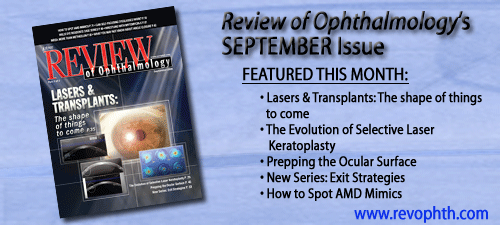BRIEFLY
- NEW TREATMENT OPTION FOR GLAUCOMA RECEIVES FDA EXPANDED 510K INDICATION. The FDA has granted 510k clearance for iScience Interventional"s canaloplasty microcatheter, for catheterization and viscodilation of Schlemm’s canal to reduce IOP in adult patients with primary open-angle glaucoma. The minimally invasive surgical technique, called canaloplasty, uses a 250-µm microcatheter to access the drainage channels; it uses the eye’s natural drainage system to remove fluid from the eye. During the 30-minute procedure, the surgeon inserts the microcatheter through a small incision, enlarges the main drainage channel and places a small suture inside the canal to maintain the opening so it can function normally. Once completed successfully, this procedure rejuvenates the native drainage system and lowers IOP. For more information, go to www.iscienceinterventional.com.
- ALCON RESEARCH INSTITUTE PROVIDES UNRESTRICTED GRANTS TO SEVEN RESEARCHERS. The Alcon Research Institute (ARI) has recognized seven outstanding researchers in vision and eye health, nominated by previous winners and selected by ARI"s independent Scientific Selection Committee. Each will receive $100,000 in unrestricted grant money from the ARI to continue pursuing their research. The 2008 ARI Award winners are: Vadim Y. Arshavsky, PhD, Professor of ophthalmology and pharmacology and Scientific Director, Department of Ophthalmology, Duke University, for his research on the behavior of G-proteins and photoreceptors in an effort to understand humans" response to light; Emily Y. Chew, MD, Deputy Director, Division of Epidemiology and Clinical Research, NEI/NIH and Frederick L. Ferris, MD, Director of Epidemiology and Clinical Research, NEI/NIH, who were jointly instrumental in designing, developing and executing the Age-Related Eye Disease Study; David R. Copenhagen, PhD, Professor and Vice Chair, Department of Ophthalmology, University of California, for his extensive work on visual system development; Reza Dana, MD, Professor in the Harvard Department of Ophthalmology, Director, Cornea Service, Massachusetts Eye & Ear Infirmary and senior scientist at Schepens Eye Research Institute, for his significant contributions in the area of corneal transplants; Elizabeth C. Engle, MD, Associate Professor of neurology, Harvard Medical School, investigator at Howard Hughes Medical Institute and senior research associate in ophthalmology at Children"s Hospital Boston, for her extensive research into the genetics of ocular defects; Simon W. John, PhD, Professor at the Jackson Laboratory, research assistant professor at Tufts University School of Medicine and investigator at Howard Hughes Medical Institute, for his distinguished career and groundbreaking research directed to understanding the underlying causes and potential treatments of glaucoma. In addition to the unrestricted grants, the awardees will join previous ARI winners in a biennial symposium in 2009 that will review, evaluate and discuss cutting-edge research into the causes and treatments of eye disease.
- BAYER AND REGENERON ANNOUNCE POSITIVE PHASE II RESULTS FOR VEGF TRAP-EYE. Bayer HealthCare AG and Regeneron Pharmaceuticals, Inc. recently announced that patients with wet AMD who are receiving VEGF Trap-Eye in a Phase II extension study on a prn dosing schedule continued to show highly significant improvements at 52 weeks in the primary and key secondary endpoints of retinal thickness and vision gain. The 32-week results of the Phase II study were presented at the 2008 ARVO meeting; a full analysis of the 52-week results of the study will be presented at the 2008 meeting of the Retina Society on September 26-28, 2008 in Scottsdale, Ariz. In the trial, 157 patients were randomized to five dose groups and treated with VEGF Trap-Eye in one eye. Two groups initially received monthly doses of 0.5 mg or 2.0 mg of VEGF Trap-Eye at weeks 0, 4, 8 and 12, and three groups received quarterly doses of 0.5 mg, 2.0 mg or 4.0 mg of VEGF Trap-Eye at baseline and week 12. Following the initial 12-week fixed-dosing phase of the trial, patients continued to receive therapy at the same dose on a prn dosing schedule based upon the physician assessment of the need for re-treatment in accordance with pre-specified criteria. Patients were monitored for safety, retinal thickness and visual acuity. These data represent the final one-year analysis from the 52-week study. All dose cohorts combined showed a 5.3 mean letter gain in visual acuity versus baseline at the week 52 evaluation visit. The mean decrease in retinal thickness for all dose groups combined at week 52 was 130 µm vs. baseline. During the week 12 to week 52 prn dosing period, patients from all dose groups combined received, on average, only two additional injections. VEGF Trap-Eye was generally well tolerated, and there were no drug-related serious adverse events. One case of culture-negative endophthalmitis/uveitis was reported in a study eye, in addition to one arterial thrombotic event, but neither was deemed drug-related. The most common adverse events were those typically associated with intravitreal injections.
|


















